CHAPTER 5
THE RIVERS WITHIN
Keep Your Vital Enery Flowing with Physical Activity, Mind-Body Exercise, and Acupressure
Lack of activity destroys the good condition of every human being, while movement and methodical physical exercise save it and preserve it.
—PLATO
MOVEMENT IS THE UNCHANGING LAW OF NATURE. We experience cosmic movement through the ceaseless circling of the planets within our solar system. The seasons come and go, the months wax and wane, day dawns and night draws near. Within your body, even while you lie still, blood circulation, intestinal peristalsis, and nerve impulses continue unabated in order to maintain normal functions. The abilities to work, play, communicate, create, and procreate all depend on movement. Whether fluid or energy, blockages within your being lead to disorder and disease. The inactive body is a residence for depression and toxins. Physical movement, mind-body exercise, and acupuncture assist the body in maintaining and restoring healthy flow.
Physical movement or exercise is one of the most important elements in preserving health and promoting wellness. But despite its well-known benefits, exercise may be the most universally despised endeavor, with many people subscribing to the following exercise program, written by an unknown author: “Too many people confine their exercise to jumping to conclusions, running up bills, stretching the truth, bending over backward, lying down on the job, sidestepping responsibility, and pushing their luck.”
If we were designed to lie down or sit all the time, we would look more like invertebrates. The key to getting off the couch is to find exercise in everyday activities and to have fun in the physical movements you choose to do. Walk instead of drive, bicycle for short errands, take stairs rather than the elevator, park the car farther from your destination, vacuum and clean your house, and enjoy gardening. If you do any of these activities regularly, you already are doing some exercise.
How about getting some fun exercise? There are aerobic exercises like skipping as you walk down the street, or running up the stairs, jumping rope, jumping on a trampoline, dancing, skating, hiking the hills, jogging, cycling, swimming, cross-country skiing, and rowing. If these don’t appeal to you, try a sport like tennis, basketball, soccer, hockey, badminton, or Ping-Pong. The varieties are endless, but the important thing is to be active every day.
Movement is essential for proper metabolism and energy circulation. Our cardiovascular and lymphatic circulatory systems rely on movement to help with the circulation of blood and the expelling of cellular waste. The movement of muscles, joints, and tendons promotes renewal and circulation and extends your range of motion, preventing arthritic buildup and stagnation. Moderate load-bearing exercise is essential for bone density and muscle strength, which is especially important as we age. Cardiovascular exercise increases heart rate and provides stimulation for the heart muscles, maintaining proper rigor and endurance. Exercise also helps us burn off excess blood sugar, preventing it from getting stored as body fat.
THE HEALTH BENEFITS OF EXERCISE
Perhaps having fun by itself won’t persuade you to exercise. Research also shows that exercise may encourage the brain to work at optimum capacity by causing nerve cells to multiply, strengthening their interconnections, and protecting them from damage. It also directly assists in learning and the healing of neurological diseases. If you’re still not convinced, with exercise you can also:
• Improve the look and feel of your skin as a result of increased blood flow.

• Boost your energy and aerobic capacity so you won’t tire as easily.

• Increase your metabolism, burn fat, and maintain a healthy weight.

• Elevate your good (HDL) cholesterol, which protects you from heart disease.

• Increase muscle tone and strength and improve your endurance.

• Enhance your sex life by promoting better circulation and hormonal stimulation.

• Decrease or normalize your blood pressure.

• Balance your blood sugar and decrease insulin resistance, which can prevent diabetes.

• Strengthen your bones, cartilage, and ligaments and lower the risk of osteoporosis.

• Improve your sleep by restoring normal body rhythms and reducing stress hormone levels.

• Lower your risk for heart disease, stroke, cancer, depression, diabetes, and other chronic degenerative diseases.

• Become happier, sexier, and more vivacious.
BEWARE THE WEEKEND WARRIOR
HOW YOU APPROACH EXERCISE MAY DETERMINE the benefits and enjoyment that you’ll get from it. I have a number of patients who are weekend warriors—people who don’t exercise much during the week but go to the extreme on weekends. They’ll engage in vigorous physical activities like mountain biking, basketball, or high-impact aerobics. And they’ll usually end up in my office with injuries. There is nothing wrong with these types of athletic activities, but when they are done infrequently they often cause injuries. It isn’t necessary to work out to the extreme or to get your pulse rate up to the maximum to get the health and weight-loss benefits of exercise. On the contrary, many studies show that regular, moderate exercise does more for your health and waistline than periodic intense workouts. When you exercise to the extreme, not only are you more prone to injuries but you also put unnecessary wear and tear on your body. And that is exactly the opposite of the point of exercise.
I’ve found that many people who exercise way too hard frequently suffer from lactic acidosis—a state in which the body is full of the waste products of excessive muscle use, causing aching in your muscles, rapid breathing, and fatigue. The tendency to go into lactic acidosis is increased by age, nutritional deficiency, obesity, hormonal imbalance, and disease. Moreover, when exercising beyond a healthy heart rate, your body switches from burning fat to burning carbohydrates for energy. The old maxim of “no pain, no gain” is destructive to many people’s health—the wear and tear of physical strain takes its toll.
FINDING YOUR OPTIMUM EXERCISE ZONE
WHAT, THEN, IS A HEALTHY RANGE FOR HEART RATE and workout intensity? The answer is simple and logical: If you strain to breathe rapidly during your physical training and feel achy and tired afterward, you’ve gone beyond the limit of what is healthy for you. A healthy range of heart rate during exercise for the average person is between 90 and 120 beats per minute. For more athletic people the range is higher. A sports medicine specialist or trainer can help you establish what is ideal for you individually. When you are in the optimum zone, exercise should make you feel energized and happy afterward, motivating you to repeat the experience over and over and over again.
From my clinical experience and research, I am convinced that it is best to exercise four times or more a week for thirty minutes at a time. It can be as simple as a brisk walk around your neighborhood, or the Merry-Go-Round Circle Walk that I describe in Part 2 of this book. If you suffer from a physically debilitating condition, are recovering from an illness, or are just terribly out of shape, start your exercise program gently and gradually. You may want to exercise only five minutes a day to start with, but do it every day. Then incrementally increase the time on a weekly basis—say, five additional minutes per week. By the sixth week you’ll be up to thirty minutes a day.
MIND-BODY EXERCISES
IT MAY COME AS A SURPRISE TO YOU that gentle, slower, and deliberate movements are just as beneficial for your health, if not better than, abrupt, fast-paced, and forceful exercises. This is particularly true as part of a self-healing program, but it is also important as you get older. Gentle, deliberate movements engage your mind, breathing, and body motion as one. Unique to China are the gentler kind of movement arts that promote energy, balance of function, and a calm mind. I call them mind-body exercises, and they include tai chi, qi gong, and Dao In Qi Gong. Certain dance forms fall into this category as well. These exercises have traditionally been associated with health and longevity. Many recent studies have confirmed their balancing action on blood pressure, blood sugar, cholesterol, equilibrium, and other organ functions. Mind-body exercise works through a system of energy communication within the body. By deliberately activating the flow of energy and removing blockages, communication is restored and organ functions return to their optimal level.
In order for you to be physically, mentally, and spiritually well, it is essential that your internal energies flow in an unimpeded and harmonious manner. What does this mean? Under ideal conditions, a person’s internal energies course throughout his or her being in much the same way as the planets and other heavenly bodies course through the vast body of the cosmos. In both cases, the movements are determined by universal natural laws. When you experience stress during the course of daily life, your subconscious mind will direct extra energy to certain areas of the body to handle the stress. Over time your body becomes habituated to energizing those areas and neglecting others, and the normal course of energy circulation becomes distorted and unbalanced. In this case, the movements no longer follow natural law. This distortion results in personal disharmony, manifesting as physical and mental diseases.
THE CIRCULARITY OF ALL NATURAL MOVEMENT
THE NATURAL MOVEMENT OF EVERYTHING IN THE UNIVERSE follows a circular pattern. The earth spins on its axis as it orbits the sun. The sun, in turn, orbits the galactic center of the Milky Way. And the Milky Way follows a circular pattern as it courses through the universe. Life itself consists of cycles, and the energies of the human organism also circulate through their microcosmic energy network. The movements of tai chi are a series of circles that reflect this eternal cosmic law.
Everything in nature follows a cyclical process of growth and evolution. All things grow and develop and, after their peak has been reached, revert to their source to regenerate again and again. The movement of evolution is not a linear process. Anything that continues in a straight line must eventually run out of power and come to an end. The multiuniverse is able to continue its process of evolution eternally because it reverts to its source for regeneration before reaching the absolute end of its impetus. You could say that the energy is recycled.
This is an essential principle of tai chi—in the movements you never extend your body or energy completely so you are left with energy in reserve. You go only to a certain point and then draw inward again to the center to gather your energy. The movement is repeated, the force is recharged, and the energy is recycled at the same time. This is called the law of reversion. In this way tai chi expresses the principle of perpetual self-regeneration.
TAI CHI AND QI GONG FOR HEALTH AND HEALING
ACCORDING TO HUA-CHING NI, AN EMINENT AUTHORITY ON TAI CHI, qi gong, and other Taoist healing arts, who also happens to be my father and teacher, “When practicing tai chi or gi gong, first the mind, afterward the body. The abdomen is relaxed, the energy is gathered into the bones, the spirit is at ease, and the body is quiet. At every moment be totally conscious.”
The ancient masters developed a system of physical movements that are based on the natural motion of the heavenly bodies. By moving the body in this fashion, we guide the internal energies to flow according to the same natural laws that keep the planets on course and the galaxies propelling through space in harmony. By practicing these mind-body exercises, you can unblock and relieve energy congestion in certain parts of the body and gradually eliminate the stress that has accumulated over the course of time. You may also redirect the flow of vitality so that every muscle, nerve, and organ is nourished and toned. Through the calmness and relaxation generated by tai chi and qi gong, the vitality that has been locked within a tense and imbalanced body is released and allowed to restore and sustain natural health.
Often when we are engaged in a physical activity our minds are engaged in an unrelated activity. Through the consistent practice of tai chi, qi gong, and other mind-body exercises, we can strengthen and integrate our physical and mental functions. People generally either engage in mental activity and are oblivious to their bodies, or they engage in physical activity but their minds are wandering and not aware of what the body is doing. In this way the body and mind, which are essentially one inseparable system, are split.
Consciousness directly influences the energy flow and the general state of energy. When this split is created and the body and mind do not function as one unit, the ability to realize our full potential is greatly impaired. Nerve synapses atrophy from lack of use and vast areas of the brain lie dormant. Input from the external environment is inaccurately or incompletely transmitted to the brain, which in turn relays faulty messages as a response. As a result, the nervous system doesn’t fully develop and the awareness of reality, both internal and external, is distorted.
THE PRACTICE OF MINDFULNESS IN MOVEMENT
THE PRACTICE OF TAI CHI AND QI GONG trains the mind to follow every detail of the body’s actions. Rather than literally scattering energy through unaware physical activity, you are able to gather energy into your being. The peaceful mental atmosphere created by tai chi and qi gong movements allows negative thought patterns to dissolve and to be replaced by positive, life-affirming attitudes.
The human body is like a tree—if energy circulates to all parts of the tree, the entire tree is full of life. However, if one part of the tree does not receive its supply of energy, then that part withers. In the human body, the energy must always be regenerated and it must be able to circulate freely to all parts of the body. In ordinary exercise, circulation is stimulated but energy is also burned up and lost in perspiration. Thus you may generate energy but you also lose energy. In tai chi and qi gong the body is allowed to blossom in perfect condition without perspiring. Your muscle tissue will be neither flaccid nor rigid but full of energy like a ripe plum.
Ordinary exercise and sports may produce quick and shallow breathing, which causes more oxygen to enter the system, but they may strain the heart and lungs when performed to extreme intensity. In tai chi and qi gong the heart is relaxed and the breathing is deep and full, which enables even more oxygen to enter the bloodstream, using the full capacity of the lungs. The rhythmic movements of these mind-body exercises produce friction between the organs, causing gentle warmth, which strengthens and fortifies them.
The expanding and contracting movements of tai chi invigorate and tone the stomach and intestines, promoting good digestion, and strengthen the entire respiratory system by using the full capacity of the lungs. The deep and rhythmic breathing that is an intrinsic part of tai chi movements allows the diaphragm to massage the internal organs and aids the circulation of fresh blood to the heart. It also promotes proper functioning of the endocrine system, which restores the chemical balance of the body, improving metabolism.
BODY-MIND INTEGRATION
TAI CHI AND QI GONG ARE THE INTEGRATION of yin and yang energy polarities. The polarization of the primal energy as it alternates between yin and yang is not a divisive or separating process but is always integrated by the power of undivided oneness. If it were a division rather than an integrated movement, the multi-universe would inevitably come to an end. The principle of undivided oneness applies in tai chi and qi gong movement as well as in the reality of daily life. For example, when we walk, each leg cooperates with the other, and both are governed by the oneness of the person who is walking.
All movement may be explained in terms of yin and yang. For example, leftward movement is yang, rightward movement is yin. Upward movement is yang, downward movement is yin. Inhalation is yang, exhalation is yin, and so forth. The movements of tai chi are a continual sequence of yin and yang movements. If there is an upward movement, then there is a downward movement to balance it. If there is a movement to the left, then there is a movement to the right to give it symmetry. Inhalation and exhalation are also coordinated with each movement so that yin and yang, which are sometimes also called the negative and positive vibrational polarities of the human energy system, are always balanced.
GENTLE RHYTHMIC MOVEMENTS
ANOTHER UNIVERSAL PRINCIPLE REVEALED in tai chi and qi gong is the idea that sudden movement causes energy to stagnate, while gentle, rhythmic movement brings about its flowing. Sudden movement must always stop quickly—there is inevitably a pause or inhibition of energy flow. A similar principle is that hasty action ultimately results in slowness because it quickly exhausts our energy, while gentle rhythmic movement can be continued with great endurance. So, for example, those who are violent can afford only one show of force at a time, and, in reality, are weak, and those who move in a gentle rhythm can keep going continually and prove to be the strongest. Or, if you try to run all the way to a distant place you become exhausted before reaching your destination, but if you walk at a comfortable pace, you will still get there, without using up all your energy. Or to put it in another way, you can spend all your energy at once running a hundred-yard dash or pace yourself and spread the energy over the twenty-six miles of a marathon. As any marathon runner will tell you, your rhythm is critical to pacing your energy. This is a fundamental principle of these exercises too, and it indicates the “constant virtue,” or constant quality, inherent in gentle rhythmic movement.
TYPES OF TAI CHI AND QI GONG FOR HEALTH AND SELF-HEALING
TAI CHI IS A CONTINUOUS, choreographed set of movements practiced in its entirety each time, while qi gong usually consists of sets of short movements that aren’t connected and are practiced repetitively in sections. Generally, qi gong is easier to learn than tai chi, and its benefits are more immediate and targeted. There are several popular styles of tai chi and many styles of qi gong. The differences between styles have to do with the family tradition they come from, their therapeutic actions, and their intent—some are geared toward martial arts, while others are healing and spiritually oriented.
Throughout this book I suggest the practice of three types of qi gong: Eight Treasures, Self-Healing, and Dao In. Eight Treasures Qi Gong is unique to my family, having been passed down for many generations. It consists of thirty-two movements divided into eight sections. Each section is designed to strengthen and promote self-healing in a particular organ network. Self-Healing Qi Gong consists of five movement sections, each targeting an organ network for balance and preventive health. Dao In Qi Gong is a set of floor exercises similar to yoga in that it involves stretching, breathing, and strengthening postures that have healing properties. Refer to the Resources section for more information about Eight Treasures, Self-Healing, and Dao In Qi Gong.
ACUPUNCTURE—AWAKENING AND ACCESSING THE RIVERS OF ENERGY WITHIN
BY UNDERSTANDING THAT GENTLE RHYTHMIC MOVEMENTS like tai chi, qi gong, and other mind-body exercises are tools for self-healing based on movement of energy within your being, you can come to appreciate the art of acupuncture. It seems incredible, but the ancient masters used their clear and unimpeded vision and recognition to compile knowledge of the energy circulation in the channel system of the human body. Even for someone who is not interested in spiritual evolution, it is valuable to understand the principles of energy within the body in order to maintain our equilibrium and health, both physically and mentally.
Acupuncture, a facet of Chinese medicine, is a precise science dealing with the processing, storage, distribution, and functioning of vital energy within the human organism and the relationship of this energy with the cosmos. Acupuncture affects the circulation of energy within the human being on an extremely subtle level. The ancient Chinese physicians discovered that there is a subtle energy manifestation circulating throughout the organs and flesh that ultimately permeates every tissue and cell of the body. The name given to this energy is chi, or qi, which has been translated as “vital energy” or “life force.” Human beings are the embodiment of all the energies of the universe, including the energies of the sun, moon, and stars as well as the various energies of the earth.
As a small universe of the larger cosmos, our being mirrors that of the natural world surrounding us. To understand the channels that carry energy within our body, we merely have to look to the melting snow packs that originated from evaporation and condensation from the seas. Snow melts, springs feed alpine lakes high up in the mountains, and the water courses its way from brooks to streams and into rivers. As it makes its way downward to ultimately rejoin with the sea, it nourishes the land that it traverses, giving rise to vegetation and living creatures. Water, then, embodies the potent symbol of life force on our planet. Likewise, what flows within the channels of our body is the life force that provides nourishment and function to our entire organism.
HOW ACUPUNCTURE WORKS
THE ENERGIES OF THE HUMAN ORGANISM have distinct and established pathways, definite directions of flow and characteristic behavior as definite as any other circulation within the body, such as the circulation of blood and lymph through their respective systems. This claim has been validated in recent years by studies of the acupuncture meridians. The ancient physicians observed that illness often produced painful areas upon the skin, and that the pain would disappear when a cure was accomplished. They also noticed that stimulation or sedation of various points on the body would produce an effect on the functioning of the internal organs. Thus stimulation of a point below the knee might affect the face, while stimulating another point on the thumb would affect the lungs or throat.
After countless years of observation and experience in treatment and response, a systematic order of these sensitive points was formulated. These sensitive points were classified into twelve main groups and two minor groups. All the points of a specific group could be connected by a line, which was considered the path the energy of the body followed as it circulated throughout the organism. These observations were correlated and refined over thousands of years, and from the results, it was deduced that lines of energy transmission existed that not only connected all of the organs of the body but also connected the external to the internal.
Modern science has begun to peer into the inner workings of acupuncture. We’ve discovered that all the parts of the body, including all its cells and molecules, form a continuous interconnected semiconductor electronic network. Each element of the organism, even the minutest part, is immersed in and generates a constant stream of vibratory information. This information records and feeds back all the events throughout the body. Whole health relates to complete connectedness. Past physical and emotional strains damage the links, causing the body’s defenses and repair systems to become weakened, and illness is often the result. Acupuncture reestablishes and balances the electronic circuitry that in turn enhances the body’s self-healing mechanism.
In 1997, the National Institutes of Health released an efficacy statement endorsing acupuncture for a variety of conditions, including postoperative pain, dental pain, tennis elbow, carpal tunnel syndrome, and nausea. In the same year, the Food and Drug Administration (FDA) reclassified the acupuncture needle from “experimental” to “medical device” status, recognizing that the acupuncture needle is a safe and effective medical instrument. There has been a wealth of research on acupuncture—a recent search of PubMed, a service of the National Library of Medicine and National Institutes of Health, found 11,778 research articles on acupuncture alone. Many studies have found that acupuncture can induce the release of endorphins in the brain, countering the destructive effects of stress hormones in addition to providing pain relief. Acupuncture can also increase the body’s production of natural corticosteroids, bringing on a reduction in inflammation and promoting self-healing. And acupuncture has been found to affect the autonomic nervous system—the part of the nervous system that automatically maintains life-sustaining functions including digestion, circulation, and respiration without conscious intervention—via mechanisms at the hypothalamic and brain stem levels, helping to promote homeostasis, or functional stability, in the body. In other words, acupuncture encourages self-regulation that leads to health and balance.
CONDITIONS THAT CAN BE TREATED WITH ACUPUNCTURE AND ACUPRESSURE
THE WORLD HEALTH ORGANIZATION HAS CITED more than forty conditions that acupuncture can treat, including addiction, asthma, common cold, ulcer, sciatica, migraine, paralysis, sinusitis, headache, depression, facial pain, neck pain, knee pain, lower back pain, arthritis, insomnia, diabetes, PMS, prostatitis, colitis, and urinary tract infections. Many studies show that acupuncture is effective in conditions ranging from environmental illness due to radiation, pesticide poisoning, exposure to toxic compounds, and air pollution to infertility, menopause, and premature aging.
Some conditions respond dramatically to acupuncture. Forinstance, researchers have found it to be effective for a variety of osteoarthritis and rheumatoid arthritis conditions, bringing relief to 80 percent of those who suffer from arthritis. Some studies show that getting acupuncture during in vitro fertilization increased pregnancy rates by over 40 percent. Because acupuncture promotes homeostasis—the automatic self-regulating system of controls that maintains the internal environment of living things and regulates the balance between the internal and the external in the body—it can significantly increase your sense of well-being. Acupuncture should be an essential part of your health and wellness program.
Can’t find a practitioner of acupuncture in your area? Don’t worry, because you can enjoy the health benefits of acupuncture at home by using finger pressure, or acupressure, on the same acupoints. Simply refer to the acupressure recommendations in Part 2 of this book. To learn more about acupuncture and acupressure, log on to www.acupuncture.com.
THE CHANNELS AND ACUPOINTS
AS I’VE MENTIONED MANY TIMES, the human body is a microcosm of the universe. Like a miniature universe, the cyclical and constant movement and transformation of fluids, molecules, cells, chemicals, and energies within the body characterize life. Chi, or life force, traverses the body within tributaries and canals that we call channels. The twelve main channels each correspond to a particular organ, and like the self-sustaining universe, the energy flows perpetually, filling the empty and draining the excess from parts of the body regulated by an intrinsic balancing mechanism. The channels play an important role in the healthy functioning of human life.
The direction of energy flow is highly important. In the human body in general and under normal circumstances, yang energy flows upward and yin energy flows downward. The front of the body corresponds to yin, the back to yang. So the yin channels flow toward the front side of the body to meet in the chest, and the yang channels move toward the back of the body. All of the channels are connected and polarized so that the energy circulates in a continuous and constant pattern.
Cutting-edge studies show that the channel system is extended into the interiors of every cell in the body through the cytoskeleton or the nervous system of the cell, and even into the nuclei that contain the genetic material. The channels are simply the transmission lines in the continuous molecular fabric of the body. The organ systems use the channels as an invisible network of communication. They are not based on a nerve, vessel, or lymphatic circulation path but are distinct pathways through which bioelectric energy and information are transported. They generally run symmetrically along both sides of the body. The channels also have internal pathways, a subject too complex to go into here.
THE TWELVE MAIN CHANNELS
1. Lung Channel (LU)—Starts at the front of the shoulders and runs down the insides of the arms to the ends of the thumbs.
2. Large Intestine Channel (LI)—Starts from the end of the index fingers and runs up the outside of the arms, to the top of the shoulders, up the sides of the neck, and crosses over the upper lip to the opposite side just along the sides of the nostrils.
3. Stomach Channel (ST)—Starts just below the eyes, runs down the cheeks, down the front of the neck, down the chest through the nipples, abdomen, front of the thighs, knees, and shins to the lateral ends of the second toes.
4. Spleen Channel (SP)—Starts from the medial side of the big toes, up the insides of the ankles, up the insides of the lower legs, knees, and thighs, over the lower abdomen, and up to the sides of the rib cage.
5. Heart Channel (H)—Starts in the armpits and runs down the inner sides of the arms to the ends of the pinkie fingers.
6. Small Intestine Channel (SI)—Starts from the pinkie finger, runs up the outside of the arms, crisscrosses through the shoulder blades, up the sides of the neck and the sides of the face to the front of the ears.
7. Bladder (Urinary Bladder) Channel (UB)—Starts at the inside corners of the eyes, runs up the corners of the eyebrows straight over the head, down to the base of the skull, the base of the neck, down along the band of muscles along the spine to the buttocks, down the backs of the thighs, the backs of the knees, the backs of the calves, to the outsides of the ankles and the feet and ends at the outside of the small toes.
8. Kidney Channel (KID)—Starts from a point in the center of the soles of the feet, runs up the insides of the feet to the insides of the ankles, up the insides of the calves, the knees, and the lower back, through the body to the lower abdomen, up alongside the navel and the center of the chest, and ends at the collarbone.
9. Pericardium Channel (P)—Starts near the outsides of the nipples, runs down the inside middle of the arms, and down to the ends of the middle fingers.
10. Triple Warmer or Triple Heater (San Jiao) Channel (SJ)—Starts from the ring fingers on the sides next to the pinkie fingers, runs up along the outside center of the arms, up the shoulders to the ears, around the back of the ears, and to the outside of the eyebrows.
11. Gallbladder Channel (GB)—Starts from the outside corners of the eyes, runs in front of the ears, up the sides of the head, up and down in an arc on the sides of the head, and comes down to the shoulders, down the sides of the body to the fronts of the armpits, zigzags across the rib cage and the sides of the abdomen and buttocks, down the outside center of the thighs and calves, and down to between the pinkie toes and fourth toes.
12. Liver Channel (L)—Starts from between the big toes and second toes, runs up the insides of the ankles, calves, and thighs, through the genitals and up to the liver in the lower chest.
Each of the channels follows its specific course of circulation, so the free flow and sufficiency of qi or its opposite—blockage or deficiency—will show up in the twelve channels. The twelve main channels connect with the organs, and disorders of the organs will be reflected in their corresponding channels. It is possible, therefore, to determine which channel is affected by studying the location and characteristics of a disorder’s symptoms and signs.
The main blockage manifestations of the twelve channels are described as follows:
1. The Lung Channel—Cough, asthma, coughing up blood, congested and sore throat, sensation of fullness in the chest, and pain in the collarbone, shoulder, back, and insides of the arms.
2. Large Intestine Channel—Nosebleed, watery nasal discharge, toothache, congested and sore throat, pain in the neck or front part of the shoulders and upper arms, noisy intestines, abdominal pain, diarrhea, constipation, dysentery.
3. Stomach Channel—Noisy intestines, abdominal distension, stomach pain, vomiting, excess hunger, nosebleed, Bell’s palsy, congested and sore throat, fever, mental disturbance, pain in the chest, abdomen, and outer part of leg.
4. Spleen Channel—Belching, vomiting, stomach pain, abdominal distension, loose stools, jaundice, sluggishness and general malaise, stiffness and pain at the back of the tongue, swelling and coldness in the inner thighs and knees.
5. Heart Channel—Chest pain, palpitations, rib pain, insomnia, night sweats, dryness of the throat, thirst, pain in the insides of the upper arms, feverishness in the palms.
6. Small Intestine Channel—Deafness, yellow in the whites of the eyes, sore throat, swelling of the cheeks, distension and pain in the lower abdomen, frequent urination, pain along the back and outer parts of the shoulders and arms.
7. Bladder (Urinary Bladder) Channel—Retention of urine, bedwetting, mental disturbance, malaria, teary eyes, nasal stuffiness or runny nose, nosebleed, headache, pain in the nape of the neck, upper and lower back, buttocks, and backs of the lower extremities.
8. Kidney Channel—Bedwetting, frequent urination, nocturnal emissions, impotence, irregular menstruation, asthma, dryness of the tongue, congested and sore throat, swelling, lower back pain, pain along the spinal column and inner thighs, weakness of the legs, feverish sensation in the soles of the feet.
9. Pericardium Channel—Chest pain, palpitations, mental restlessness, stifling feeling in the chest, flushed face, swelling under the arm, mental disturbance, spasm of the arms, feverishness in the palms.
10. Triple Warmer (San Jiao) Channel—Abdominal distension, bedwetting, difficulty urinating, deafness, ear ringing, pain in the outer corners of the eyes, swelling of the cheeks, congested and sore throat, pain in the backs of the ears, shoulders, and outer parts of the arms and elbows.
11. Gallbladder Channel—Headache, pain in the outer corners of the eyes, pain in the jaw, blurring of vision, bitter taste in the mouth, swelling and pain in the collarbone, pain in the armpits, pain along the outer parts of the chest, ribs, thighs, and calves.
12. Liver Channel—Low back pain, fullness in the chest, pain in the lower abdomen, hernia, headache on top of the scalp, dryness of the throat, hiccups, bedwetting, difficulty urinating, mental disturbances.
THE EIGHT EXTRAORDINARY CHANNELS
THE EIGHT EXTRAORDINARY CHANNELS can be viewed as a regulating mechanism or reservoir for the twelve channels. When there is an excess or deficiency of energy along the twelve main channels, the eight extraordinary channels start to function. They store excess energy or provide stored energy from the kidney network, which includes the hormonal system. This “give and take” reservoir process is a self-regulating function but can be activated and accessed through certain acupoints called control points, where energy converges. You can also regard them as automatic valves, so when you stimulate a control point with an acupuncture needle or finger pressure, your body’s self-regulation mechanism kicks in and initiates the repair and regeneration.
The eight extraordinary channels have their own distinct pathways; they borrow points by crisscrossing the twelve main channels, all except the Governing (DU) and Conception (REN) channels, which have their own distinct points.
The pathways of the eight extraordinary channels are described as follows:
1. Governing (DU) Channel—Originates from the inside of the lower abdomen. Descending, it emerges at the perineum, the area between the external genitals and the rectum, and then ascends along the interior of the spinal column to the nape, where it enters the brain, ascends to the top of the head, and comes down the forehead to below the nose.
2. Conception (REN) Channel—Originates from the lower abdomen and emerges from the perineum. It runs to the pubic region and ascends the front midline to the throat. Running farther upward, it curves around the lips, passes through the cheeks, and enters the region below the eyes.
3. Vitality (Chong Mai) Channel—Originates from the lower abdomen, descends and emerges from the perineum, then ascends and runs inside the vertebral column, while its superficial portion passes above the genitals, where it splits into two and coincides with the kidney channel, running up to the throat and curving around the lips.
4. Belt (Dai Mai) Channel—Starts below the lowest rib. Running obliquely downward, it runs transversely around the waist like a belt.
5. Yang Connecting (Yang Qiao) Channel—Starts from the sides of the heels. Ascending along the legs, it goes along the lateral aspects of the thighs. From there it winds over to the shoulders and ascends along the neck to the corners of the mouth. Then it enters the inner corner of the eyes to communicate with the Yin Connecting (Yin Qiao) channel. It then runs farther upward along the urinary bladder channel to the forehead, where it meets the Gallbladder Channel.
6. Yin Connecting (Yin Qiao) Channel—Starts from the insides of the feet in front of the ankle bones and ascends along the calves and thighs to the external genitalia. From there it ascends up the chest to the collarbone. Running farther upward alongside the Adam’s apple and then along the cheekbones, it reaches the inner corners of the eyes and communicates with the Yang Connecting (Yang Qiao) channel.
7. Yang Regulating (Yang Wei) Channel—Begins at the sides of the feet. Ascending to the external ankle bones, it runs upward along the gallbladder channel, passing through the hip region and farther upward to below the ribs and the posterior armpits to the shoulders. From there it ascends to the forehead and then turns backward to the back of the neck, where it communicates with the Governing (DU) channel.
8. Yin Regulating (Yin Wei) Channel—Starts from the insides of the legs and ascends along the thighs to the abdomen to communicate with the spleen channel. Then it runs along the chest and communicates with the Conception (REN) channel at the neck.
ACUPOINTS FOR HEALTH AND WELL-BEING
THE EIGHT CONTROL OR CONFLUENT POINTS are used to activate the eight extraordinary channels at locations where they communicate with the twelve main channels. When symptoms are experienced, stimulation of the corresponding control points will help activate self-balancing and healing. Their locations are described below.
1. SI-3 (Back Stream point)—Activates the Governing (DU) channel. When a loose fist is made, the point is found in the depression at the end of the crease below the base of the little finger.
Indications: Headache with stiff neck, redness in the eye, deafness, epilepsy, malaria, fever, night sweats, psychosis, nosebleed, paralysis of the upper extremities, high blood pressure, hysteria, rib pain, low back pain, nerve pain in the legs, jaundice, fullness in the chest, hand tremors, and spasm of elbows, arms, and fingers.
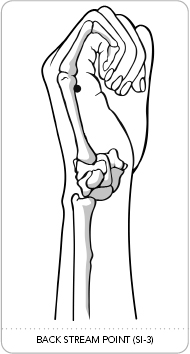
2. LU-7 (Branching Crevice point)—Activates the Conception (REN) channel. On the side of the forearm just above the bony prominence, about one and a half thumb-widths above the inside crease of the wrist at the base of the thumb.
Indications: Cough, sore throat, facial paralysis, headache, neck stiffness, toothache, wrist weakness, asthma, acute swelling of the extremities, hot palms or heat in palms, trigeminal neuralgia, hives, facial spasms, radial neuralgia, pain in the elbows, malaria, chills in the back, lack of energy, epilepsy, phlegm obstructing the throat, vomiting of phlegm, swelling of the shoulders, rheumatism of the shoulders, sensation of heat with sweating on the chest and back, sensation of cold in the chest and back.
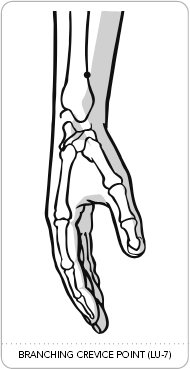
3. SP-4 (Heredity point)—Activates the Vitality (Chong Mai) channel. On the inside of the foot, above the middle arch, in the depression below and in front of the bone extending back from the big toe.
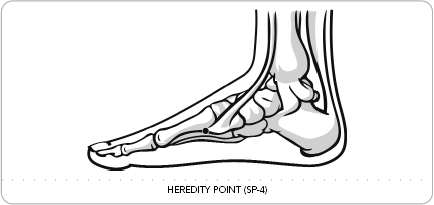
Indications: Vomiting, diarrhea, poor digestion and appetite, abdominal or stomach pain, dysentery, noisy intestines, epilepsy, swelling, facial swelling, endometriosis, irregular menstruation, menstrual cramps, tidal fever, fever with abundant sweating, thirst, chest pain, discomfort in the heart region, sighing often, high blood pressure, pain or paralysis of the big toe and bottom of foot, rest of foot, and ankles.
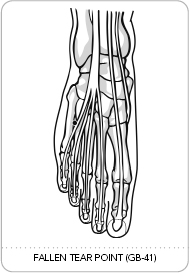
4. GB-41 (Fallen Tear point)—Activates the Belt (Dai Mai) channel. About one inch toward the ankle from the junction of the two smallest toes (in the depression behind the small tendon and between the bones).
Indications: Conjunctivitis, dizziness, blurry vision, pain in the sides of the ribs, breast infection, swelling and pain of the tops of the feet, irregular menses, headache, vertigo, dizziness, shortness of breath, ear ringing, deafness, arthritis, chest pain with chills, excess sweating, pain in the collarbone, pain and coldness in the hips, extremities, and calves.
5. UB-62 (Expanding Vessel point)—Activates the Yang Connecting (Yang Qiao) channel. In the depression directly below the tip of the anklebone on the outside of the leg (opposite KID-6).
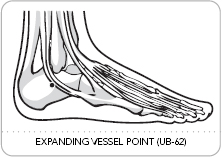
Indications: Headache, dizziness, vertigo, Ménière’s disease, pain in the low back and legs, epilepsy, psychosis, tinnitus, stroke, insomnia, painful menses, foot swelling, arthritis of the lower extremities, palpitations, fever and chills, meningitis, high blood pressure, eye pain, nosebleed, swelling of the neck and armpits, paralysis, tiredness.
6. KID-6 (Illuminate the Sea point)—Activates the Yin Connecting (Yin Qiao) channel. In the indentation directly below the inner tip of the anklebone (opposite UB-62).
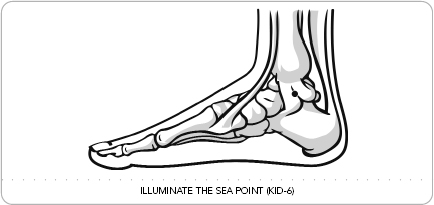
Indications: Dry sore throat, irregular menses, uterine prolapse, vaginal discharge, itchy vulva, frequent urination, urinary retention, constipation, foot and leg, epilepsy, psychosis, insomnia or sleepy all the time, hernia, eye pain, vision problems, menstrual cramps, fever, asthma, loss of appetite, bedwetting, dark urine, pain and weakness of the extremities, postpartum abdominal pain, cramps in the hands, headache.
7. SJ-5 (External Gate point)—Activates the Yang Regulating (Yang Wei) channel. Two thumb widths away from the crease of the wrist on the outside forearm, halfway between the bones (opposite P-6).
Indications: Headache, ear ringing, deafness, pain in the fingers, pain in the elbows and arms, hand tremors, fever, common cold, pain in the cheeks, mumps, pain in the ribs, constipation, swollen throat, bedwetting, stiff neck, paralysis, inflammation of the eyes, teary eyes, cataracts.
8. P-6 (Inner Gate point)—Activates the Yin Regulating (Yin Wei) channel. Two thumb widths away from the crease of the wrist on the inside forearm, between the two tendons (opposite SJ-5).
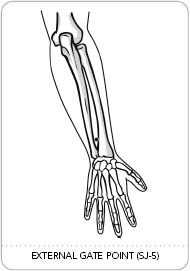
Indications: Chest pain and fullness, palpitations, epilepsy, vomiting, contracture and pain of the elbows and arms, malaria, fever, delirium, stomach pain, psychosis, hiccups, stroke, jaundice, postpartum vertigo, asthma, shock and emotional trauma, migraine headache, hyperthyroidism, swollen and painful throat, postoperative pain, hemorrhoids, rheumatic heart disease.
By stimulating these and other acupoints with your fingers, you will discover their healing actions and experience the magic of your body’s self-healing capabilities.
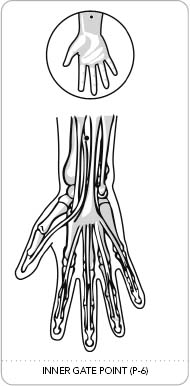
In summary, whether it’s through enjoyable physical exercise, playful sports, or serene tai chi, with mind-body movement you are activating and circulating the vital substances of your being—energy and fluids—that sustain health, vitality, and life itself. The life force can be further stimulated in the energy network of the body through acupuncture and the simple self-healing art of acupressure. Learn to turn on your body’s powerful healing capabilities and your body will thank you for it.